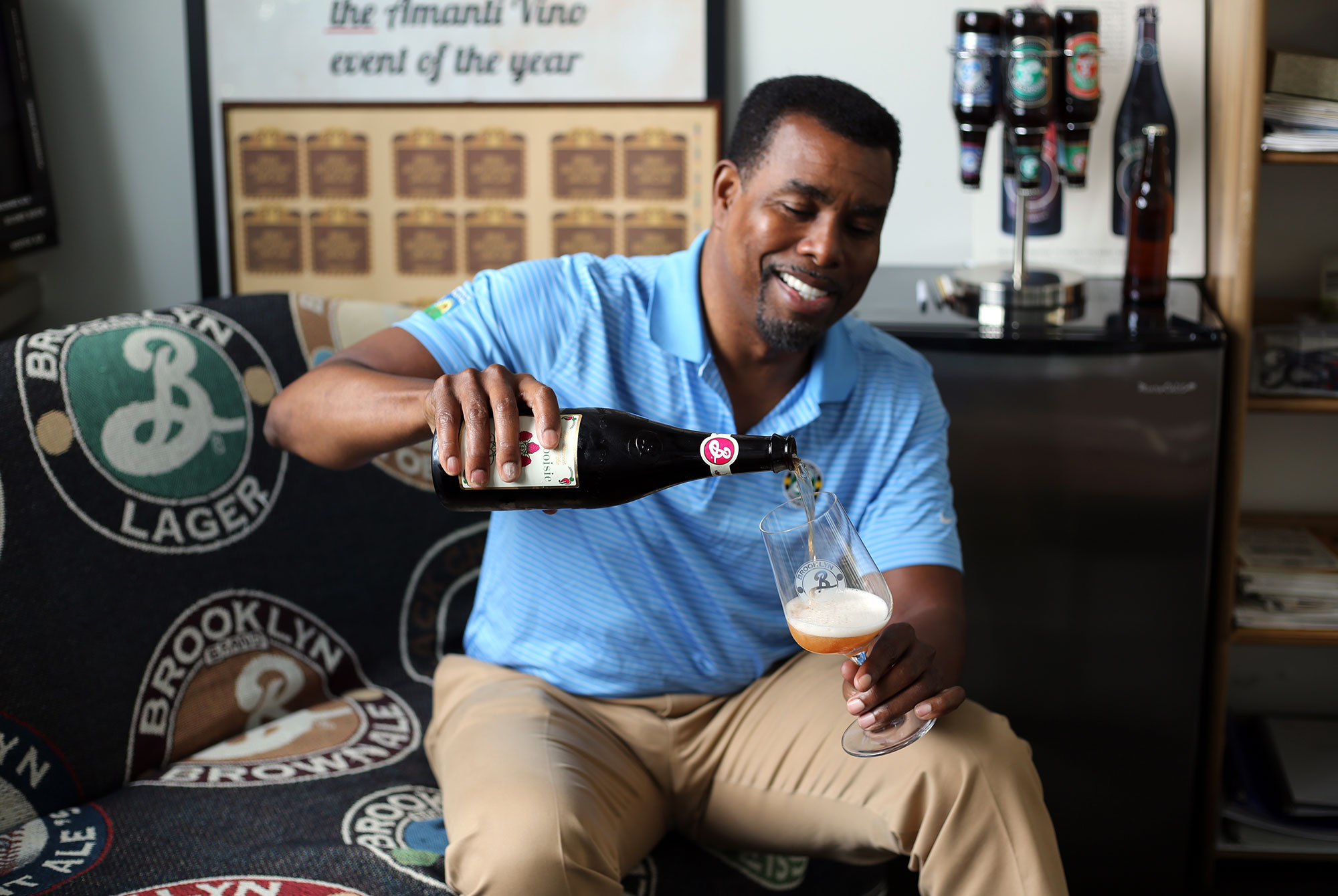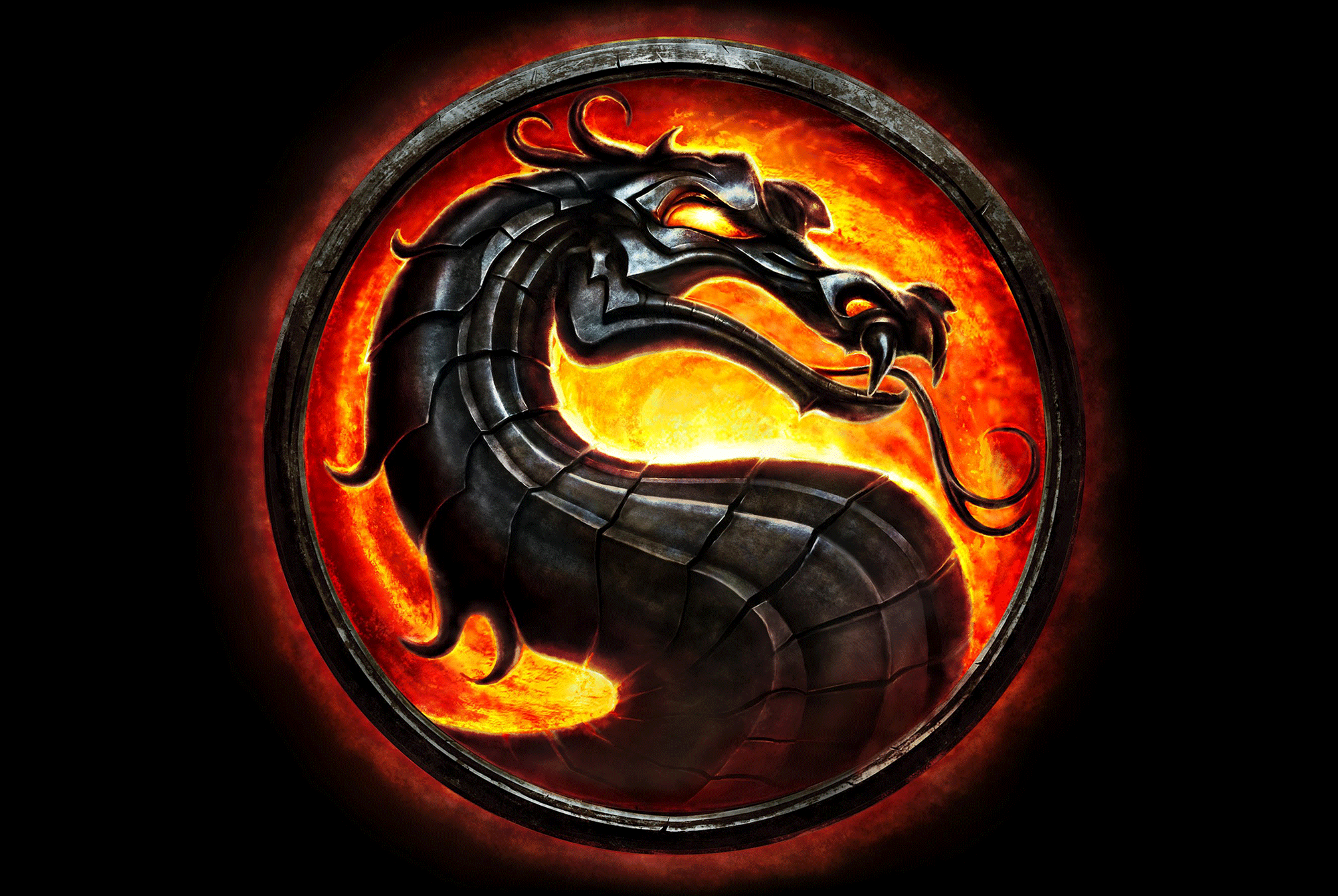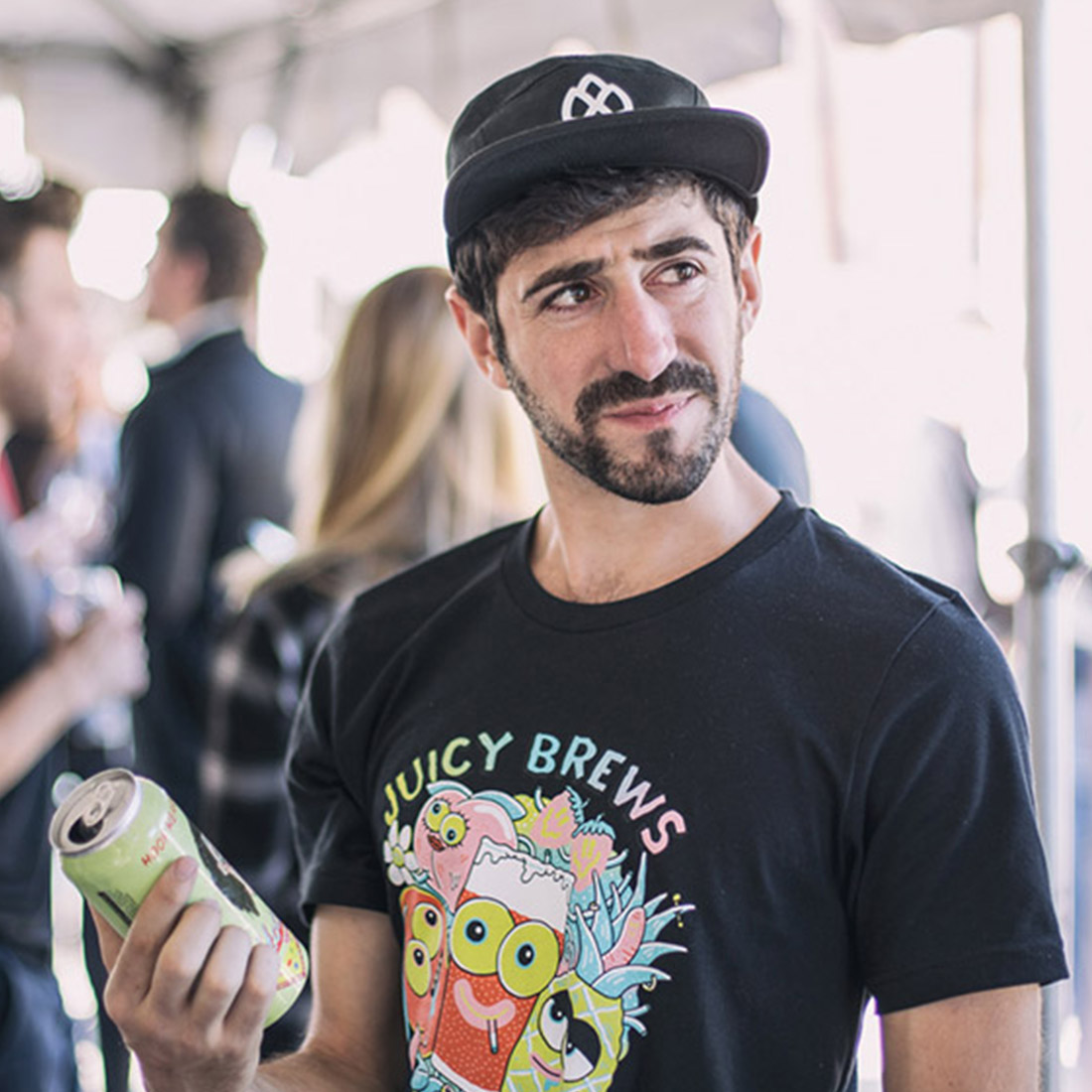Shop
A Pint with Garrett Oliver
Hop Culture sits down with Brooklyn Brewery's brewmaster to talk socks, sours, and social justice.
Things we learned:
- Obama would make a cool brewing partner
- Garrett Oliver admires snappy socks
- Torulaspora yeast gives apples their apple-y flavor
- Brewing a beer is a lot like making a movie
- In order to make brewing more inclusive, the craft industry needs to make their ads more inclusive of minority and historically marginalized populations
Who comes to brewing from a straight path? Certainly not Garrett Oliver, who started his career managing rock bands. But after drinking real ales in England, Oliver began brewing on his stove, eventually becoming president of the New York City Homebrewer’s Guild. There he met Steve Hindy, who in 1994 invited Garrett to be the head brewer of an ambitious new project: Brooklyn Brewery. Over the course of the next two decades, the vivacious brewmaster helped set the tone for America’s craft beer climate, conducting over nine hundred tastings across sixteen countries and writing or editing several beer industry bibles: The Good Beer Book, The Brewmaster’s Table, and The Oxford Companion to Beer. Craft beer’s leading spokesman sat down with Hop Culture to talk socks, sours, and social justice.
Kenny Gould: I understand that you invented beer collaborations.
Garrett Oliver: That’s what I understand. A British guild of beer writers had actually looked into it and told me that was the case.
KG: Okay then. If you could invite anyone, alive or dead, in the beer industry or not, to come into the brewery and collaborate on a beer, who would you bring in?
GO: That’d be pretty easy considering I know that they’ve been brewing beer in the White House — President’s Homebrew. I wrote about this for the Times actually. I’d always pitched the idea that maybe I’d come brew at the White House someday. They had other things to worry about, but it’d be great to have Obama and his crew here to bring that presidential brewing thing full circle.
[looks at Kenny’s socks]
By the way, I appreciate a strong sock game.
KG: Thanks. Let’s talk about the Ghost Bottle Series, the experimental one-offs you make in house that aren’t usually for sale. Without revealing too many trade secrets, I was wondering if you could tell me more about them. How many ghost bottles do you have?
GO: Altogether, we have about 75 ghost bottles. Actually, we have more ghost bottles than beers we actually release. In a way that’s not surprising, since the ghost bottles are super experimental. Often, they’re things that can’t be recreated at all. For example, we have a bottle called Chichicapa where I got six barrels from the guys at Del Maguey. They actually filled six Pappy Van Winkle barrels with Chichicapa Single Village Mezcal, did two turns in the mezcal barrels and then sent all six barrels to me. I put our beer, Local 1, into the barrels for a year and then re-fermented it in bottles with champagne yeast. We love that beer, but those six barrels are the only six barrels in the world, and there aren’t going to be more. So you have 80 cases and you’re done.
[page_slider]Or they’re things that can’t be created here, at this time. We have a new beer called Serpent which we just released in the UK; it’s a collaboration between us and Thornbridge in England and Tom Oliver’s cidery. This comes out of years of doing beers based on sediments, which we call lees, from natural wine and cider fermentations. When the natural, wild fermentation is finished, they give us the yeast sediment. We transfer it into a barrel, and then we age that beer for a year or more. I sent over the recipe and the barrels and Thornbridge made the beer, and then we put it in barrels over Tom Oliver’s lees. That beer is out in the UK. It’s something that we could only make outside of the United States, where there’s actually enough natural fermentation happening to have the material to make it happen.
But there are other things that grow from ghost bottles into marketable beers. When you came in, you may have seen that we’re filling some bottles with a brettanoymces-fermented porter. The first time we did that beer, we did it for an event called Savor. It was single batch, we really liked it and brewed it for draft. Just a strong porter—we put some of that down in barrels just for ourselves. None of that is left in the brewery—it was like a holiday present for everyone. I know Dan Petrovsky down at the Larkmead winery, [so] we got 180 Larkmead red wine barrels. We brewed a stronger version of this porter and we’re now laying that down. That’ll be something that next year sometime will be available. No name for it yet. A couple in mind.
KG: What small brewery is doing really interesting things right now?
GO: It depends what you mean by “interesting things.” Certainly there are guys like Prairie Artisan that are doing some fun, funky stuff, though they’re a lot more established. I think that Allagash doesn’t get the credit they deserve for things like their Coolship series. People are now doing it elsewhere but those guys have been at it for a while. Then there are other people doing really good work overall. Societe out in San Diego started making really nice beers as soon as they got started. There’s a lot of fun stuff happening around.
KG: Are there some technologies or different recipes that you’ve been experimenting with that no one else has tried yet?
GO: Certainly the thing that I was talking about where we’re doing natural fermentation from another fermented base. There are certainly other things that we’re working on from a more technical level, like trying to get certain Brettanomyces strains to do what we want in a more predictable fashion. And I’m interested in looking at what kinds of characteristics can be created by less-known yeast strains. There’s one called Torulaspora which is derived from the skins of apples and may very well be among the things that make an apple smell or taste like an apple, because when Torulaspora ferments it creates apple-like aromatics. We have a beer we’re laying down right now which is going to be in a blend of calvados and applejack barrels and is also fermented by this apple-derived yeast. And we’re bringing this whole apple thing together in a concentrated form. It’s almost like “Apples Five Ways” or something, without necessarily any actual apples—though we might eventually use them in some dried form in the barrel.
KG: Then you have to call it Apples Six Ways.
GO: [laughs]
KG: I understand that you have a fairly extensive knowledge of both movies and literature. If you could recommend a book and movie to another aficionado, what would they be?
GO: I enjoy literature but film is what I actually studied. My degree is in broadcasting and film. Films, there are too many to name. Books… I used to stage manage rock bands as well and I just read John Fine’s book Your Band Sucks. It’s an awesome name and an awesome book. I know John Fine—he’s had the book out for a while and I have to admit, it’s one of those things like, “Oh, your friend wrote a book. I’ll read it one of these days.” And then you don’t. But I read it and I started texting him going, “Dude, this book is great. It’s really good.”
KG: Are there any parallels you see between your film work and brewing?
“In a film, there’s a thing you’re trying to get across, it’s the story. The beer, in a way, is also story.”
GO: To me, they’re mentally exactly the same thing. In a film, there’s a thing you’re trying to get across, it’s the story. The beer, in a way, is also story. It plays out like a story—it has a beginning, middle, and end, you want it to be interesting throughout. It has a color that you want, it has a look that you want, it has a feeling that you want, there are occasions in which you expect people to drink it. Just the same way that there’s a date movie, and a date movie is kind of a thing, there are some movies where you’re like, “That’s definitely not a date movie.” There are beers that go on the dinner table but aren’t fishing boat beers. I mean, you could drink them on a fishing boat but somehow they wouldn’t really fit. I think that beer, like that, is situational.
Beers and films are also a perfect blend between art and science. When I watch a film, I don’t watch a film in the same way that everybody else watches a film. I see where the camera is, how the camera is mounted, what the camera is moving on, where the light sources are. If there’s a light in a car that’s coming from below someone’s chin in some weird way, I’m the guy looking at the light saying, “Where’s that light supposed to be?” Because there’s no light like that in a car and it’s not outside. I have a hard time turning that part of my brain off. But at the same time, when someone does a beautiful job I’m like, “Whoa. That’s a good job and it’s really hard to do.”
If you have the science and no art, you end up with a Jerry Bruckheimer movie which you don’t care about when you leave the theater—you’ll never remember it again. You don’t care about the characters because there was no plot development, nobody bothered to do any writing, it’ll make money, someone will go see it, but they’ll probably be a little sorry about it. You know, Kenny G can play the saxophone, blood will run out of your ears, but there’s no soul in it. But, at the same time, if you have art and no science, you can’t actually do the thing you came to do. You have to have technique and actual ability. Just because you have great ideas about a film, if you’re now a director and you don’t know anything about lighting or how to position a camera or you don’t know anything about the actual equipment, how are you going to make the film? You can’t make the film. I think you need half and half: the science brain and the artistic brain. The artistic brain tells you where to go and the scientific brain tells you how to get there.
KG: Do you want to talk about this beer you picked for us to drink? The Discreet Charm of the Framboisie?
“I’ve had a lot of great sour beers… I’ve had so many bad ones.”
GO: Sure. [opens bottle] That’s always a great sound. It’s the sound of something good about to happen. [starts pouring beer] This is a beer that we first did as a ghost bottle as well, and speaking of film, I named it after the Buñuel film, The Discreet Charm of the Bourgeoisie. The underlying style is framboise. In this case it’s actually based on a kettle sour beer into which you put a whole lot—like, fifteen pounds per barrel—of fresh raspberries. Several months in the barrel and then we came back, added more raspberries before bottling, and re-fermented the beer in the bottle with brettanomyces. It’s bright, fresh, tart. On a warm day, or if you get a cheesecake going, you can have a lot of fun. One of my favorite lines in the movie This is Spinal Tap is, “It’s such a fine line between stupid and clever.” And I feel that way about sour beers. I’ve had a lot of great sour beers… I’ve had so many bad ones. I’m talking the wrong kind of sourness, a sourness that’s not focused well enough, a beer that’s too sour to drink, not fun anymore, or whatever else. Discreet Charm isn’t the most complex beer we’ll ever make, but it’s a drinker. I like it.
KG: I have to ask, where do you source fifteen pounds of raspberries per barrel?
GO: We got suppliers through our friends at Fresh Direct. One thing we plan to do this year is source things out of the Greenmarket for our specialty stuff so we’ll definitely be looking for ghost bottles in things or even larger projects. We’re looking at what’s going to be in the Greenmarket and we’ll get that directly from the farmers. We stay away from extracts, juices, and purees. Not that you can’t make great beers from those things, but when we’re doing fruit, we like to use whole fruit. It fits the ethos of the brewery.
KG: So one thing that I’m interested in is social justice. Beer has been found in almost every culture around the world, but here in the US we seem to have a specific focus that appeals to a certain demographic. How do you think we can expand the world of beer to include more people and make the industry more inclusive?
GO: There’s a socioeconomic part of that question and then there’s a cultural part of that question. When people have disposable income, they can think of craft beer. When they don’t have disposable income, they can’t think about craft beer or craft anything else except as a real big luxury item. We don’t look at most of our beers as huge luxury items; we look at them as what you might call “affordable luxury.” Which could be as simple as getting Häagen-Dazs or whatever your favorite ice cream brand that you can find everywhere. Or Ben and Jerry’s. A little bit better than your regular stuff, but worth it and not that expensive. Bottles like this are going to be expensive. So you’re already rarifying the number of people who are going to buy it. This is the socioeconomic part.
But then there’s the culture part, where to the extent that as craft brewers we do marketing at all, we tend to fish where the fish are. We don’t have money to go out with a loudspeaker. When you see an ad from us—you rarely would, but you’d see it in a beer publication—who’s reading the beer publication? People who are in the beer clubs and all their friends are drinking the same stuff. I think that people don’t bring themselves into this because they don’t feel included. They don’t see themselves in any of the images around it, and it’s really very much like fine dining. In a place like NYC you’ll find that a pretty good percent of people, like African Americans, for example, could afford to go to certain types of restaurants, [but] you simply never see them there. Because there’s not an image made around a place like that that’s in any way inclusive. Up until recently, brewers have customarily tended to shut out women. Especially from the big brewers, the ads were openly misogynistic and sexist and had a message that said, “You’re not welcome here.” Hopefully craft beer is different and I think that it is different. In doing that, we’ll welcome other people into the culture.
KG: Is it a brewery’s job to create welcome copy or advertising?
GO: Yeah, and also to show people: look, if you have an ad or a website, show people of different gender, background, this that and the other thing, and show a blend of real people who are enjoying the beer. Some of them are going to be black, some of them are going to be Chinese. Some of them are going to be gay. Everybody likes good stuff. Rather than, yes, everyone is this age and has this beard style, etc. It’s not even true. And if it is true, it ought not to be be.
KG: That was an interesting and measured response.
GO: The unmeasured response goes so far into Ta-Nehisi Coates land that there’s no way back from it.
KG: Did you read Coates’ book Between the World and Me?
GO: I did read that book. I thought that it was a brilliant book and a brilliant piece of writing. Interestingly, he has his own difficult path trying to figure out what his connection is going to be with his culture. There was a great thing on NPR with him being interviewed by his old best friend and they’re talking about what it’s like for him to become a rock star. Interestingly, they were talking about Marcus Samuelsson’s Red Rooster up in Harlem and Coates says, “I hate that place, it’s really bougie.” And it’s like, “Wait, you moved your whole family to Paris, and you’re on every magazine cover, did you just call someone else bougie? Really?” But at least I think he’s very honest about it. And I like the fact that he doesn’t try to pretend that he’s not angry.
KG: But it feels like a righteous anger.
GO: I think it’s a very righteous anger and most people try to hide it and say, “Oh, we’ll forgive,” and he’s like, “Nope, don’t forgive you.”
KG: Thank you for your time.




